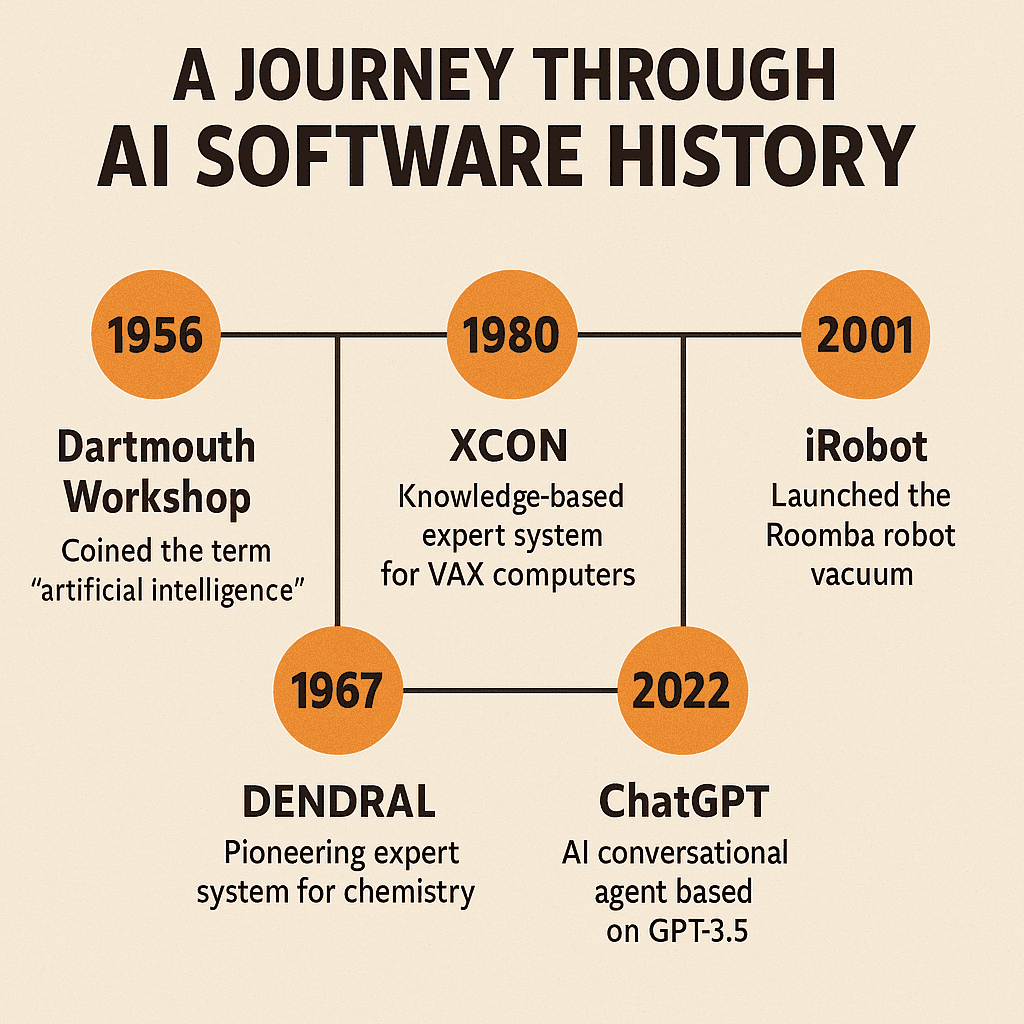
The Beginnings of AI Software
Artificial Intelligence (AI) has been a subject of fascination and study for many decades, significantly impacting our technological landscape. The journey of Through AI Software began with the exploration of concepts and theories that laid the groundwork for what we now recognize as AI. The early stages of AI were marked by ambitious visions, theoretical postulations, and foundational research that paved the way for the practical applications we see today.
Initial Concepts and Theories
The inception of AI as a field can be traced back to the mid-20th century when the idea of creating machines that could simulate human intelligence started gaining traction. The notion was fueled by the desire to understand and replicate the cognitive processes of the human mind. During the early 1950s, pioneers like Alan Turing proposed frameworks that questioned whether machines could think, introducing the Turing Test as a way to evaluate a machine’s ability to exhibit intelligent behavior indistinguishable from that of a human.
- Alan Turing: Often regarded as the father of computer science, Turing’s work laid the conceptual foundation for AI. He introduced the concept of a “universal machine,” which could simulate any algorithmic process.
- John McCarthy: Credited with coining the term “Artificial Intelligence” in 1956, McCarthy believed in the potential of machines to perform tasks that required human intelligence.
- Marvin Minsky: A key figure in AI’s formative years, Minsky’s work in neural networks and robotics contributed significantly to AI’s development.
These early theorists and their groundbreaking ideas were instrumental in transitioning AI from a purely theoretical pursuit to a field ripe for practical exploration. Their contributions spurred the creation of initial AI programs in the late 1950s and early 1960s, which, although rudimentary by today’s standards, demonstrated the potential of AI applications.
Key Figures in Early AI Development
The transition from theoretical frameworks to practical applications was propelled by several key figures whose contributions were integral to AI’s advancement. These pioneers brought diverse perspectives and expertise from fields such as mathematics, computer science, psychology, and neuroscience.
- John McCarthy: His development of the Lisp programming language was pivotal, providing a flexible framework for AI research. Lisp became the standard programming language for AI applications for decades.
- Herbert Simon and Allen Newell: Their work on the Logic Theorist and General Problem Solver programs showcased the promise of AI to automate reasoning processes.
- Arthur Samuel: Known for his work on machine learning, Samuel developed one of the first self-learning programs, a checkers-playing program that improved through experience.
Each of these figures contributed unique insights and innovations, helping to transform AI from a theoretical construct into a field with tangible applications. Their efforts were critical in establishing the foundational principles that continue to influence AI research and development.
The Transition from Theory to Practice
The leap from theory to practice in AI was marked by significant milestones and breakthroughs. The early 1960s saw the development of the first AI programs capable of carrying out tasks that required rudimentary forms of reasoning and learning. These programs, such as ELIZA and SHRDLU, demonstrated the feasibility of AI applications in processing natural language and understanding simple instructions.
- ELIZA: Developed by Joseph Weizenbaum, ELIZA was one of the first programs to attempt natural language processing. It mimicked a psychotherapist, engaging users in conversation that was surprisingly human-like.
- SHRDLU: Created by Terry Winograd, SHRDLU demonstrated the ability of a computer to understand and manipulate objects in a virtual environment through natural language commands.
The transition from theoretical AI to practical applications was not without challenges. Early AI systems were constrained by limited computational power and a lack of comprehensive data. However, these initial programs laid the groundwork for future advancements, proving that machines could mimic certain aspects of human intelligence and setting the stage for subsequent innovations.
Significant Developments in AI Software
As AI continued to evolve, significant developments in the field emerged, driven by breakthroughs in machine learning algorithms and the advent of expert systems. These advancements expanded the capabilities of Through AI Software, enabling more sophisticated and versatile applications.
Breakthroughs in Machine Learning Algorithms
Machine learning, a subset of AI, has been at the forefront of AI advancements, providing systems with the ability to learn and improve from experience without being explicitly programmed. The development of new algorithms has been instrumental in enhancing the performance and applicability of AI software.
- Neural Networks: Inspired by the structure and functioning of the human brain, neural networks are capable of recognizing patterns and making decisions based on input data. The resurgence of interest in neural networks in the 1980s, particularly with the development of backpropagation algorithms, revolutionized machine learning.
- Support Vector Machines (SVM): Introduced in the 1990s, SVMs have been widely used for classification and regression tasks, offering high accuracy and efficiency.
- Deep Learning: A more recent advancement, deep learning involves neural networks with many layers (deep neural networks), capable of processing vast amounts of data and achieving state-of-the-art performance in tasks such as image and speech recognition.
These breakthroughs in machine learning algorithms have significantly enhanced the capabilities of AI software, enabling more accurate predictions, better decision-making, and the ability to handle complex real-world tasks.
The Development of Expert Systems
Expert systems, a hallmark of early AI, were designed to mimic human expertise in specific domains. They utilized a knowledge base and inference rules to solve complex problems, making them valuable tools in various industries.
- MYCIN: One of the earliest expert systems, MYCIN was developed in the 1970s for diagnosing bacterial infections and recommending antibiotics. Its ability to perform at a level comparable to human experts demonstrated the potential of AI in healthcare.
- DENDRAL: This expert system was used in chemistry for molecular structure analysis, showcasing AI’s applicability in scientific research.
- XCON (also known as R1): Developed by Digital Equipment Corporation, XCON was used for configuring orders of computer systems, highlighting AI’s utility in manufacturing and logistics.
The development of expert systems marked a significant advancement in AI, illustrating how AI software could replicate human decision-making processes and provide valuable support across various domains.

The Impact of Big Data on AI Software
The advent of big data has had a transformative impact on AI software, providing the fuel necessary for training machine learning models and driving AI innovation. With the exponential growth of data generated by digital interactions, AI systems can now access vast datasets, enabling more accurate and comprehensive analyses.
- Data Availability: The proliferation of data from sources such as social media, IoT devices, and online transactions has expanded the horizons for AI applications, allowing for more nuanced insights and predictions.
- Improved Algorithms: Access to large datasets has facilitated the development of more sophisticated algorithms capable of handling complex tasks and delivering better performance.
- Real-time Processing: Big data technologies have enabled real-time data processing, allowing AI systems to make timely decisions and adapt to changing conditions.
The synergy between big data and AI has opened new avenues for innovation, enhancing the ability of AI software to provide actionable insights and drive decision-making in real-time.
Overcoming Hurdles in AI Software
As AI software continues to develop, it faces several challenges that need to be addressed to ensure its successful integration and application. These hurdles include data privacy concerns, computational challenges, and navigating ethical considerations.
Addressing Data Privacy Concerns
With the increasing reliance on data for AI applications, data privacy has become a paramount concern. Ensuring the protection of personal information while leveraging data for AI requires a careful balance between innovation and privacy.
- Regulatory Frameworks: Legislation such as the General Data Protection Regulation (GDPR) in Europe and the California Consumer Privacy Act (CCPA) in the United States has established guidelines for data protection, emphasizing the need for transparency and user consent.
- Data Anonymization: Techniques such as anonymization and pseudonymization are employed to protect individual identities while still allowing data analysis.
- Secure Data Handling: Implementing robust security measures to protect data integrity and confidentiality is crucial to maintaining trust and compliance.
Addressing data privacy concerns is essential for fostering public trust in AI technologies and ensuring their ethical and responsible use.
Solving Computational Challenges
The computational demands of AI software pose significant challenges, particularly as models become more complex and data volumes increase. Overcoming these challenges is critical for enhancing the efficiency and scalability of AI systems.
- Hardware Advancements: The development of specialized hardware, such as Graphics Processing Units (GPUs) and Tensor Processing Units (TPUs), has accelerated AI computations, enabling faster and more efficient processing.
- Cloud Computing: Leveraging cloud computing resources allows for scalable storage and processing capabilities, facilitating the handling of large datasets and complex models.
- Optimized Algorithms: Research into more efficient algorithms and techniques, such as model compression and distributed computing, helps reduce computational overhead and improve performance.
By addressing computational challenges, AI software can achieve greater efficiency and scalability, enabling its application across a wider range of tasks and industries.
Navigating the Ethical Landscape
The ethical implications of AI are a significant consideration as the technology becomes more integrated into society. Navigating the ethical landscape involves ensuring that AI systems are developed and deployed in a manner that aligns with societal values and norms.
- Bias and Fairness: Ensuring that AI systems are free from bias and promote fairness is critical, particularly in applications that impact individuals’ lives, such as hiring, lending, and law enforcement.
- Accountability: Establishing clear lines of accountability for AI decisions and actions is necessary to ensure transparency and responsibility.
- Human Oversight: Maintaining human oversight and intervention in AI systems helps safeguard against unintended consequences and ensures ethical decision-making.
Navigating the ethical landscape requires a collaborative effort from policymakers, researchers, and industry stakeholders to establish frameworks and guidelines that promote the responsible development and use of AI technologies.
Envisioning the Future with AI Software
The future of AI software holds immense potential for innovation and transformation. As technology continues to advance, AI is poised to play an increasingly integral role in shaping societies and addressing complex global challenges.
Innovations in AI Technology
The landscape of AI technology is constantly evolving, with new innovations and breakthroughs driving the field forward. Emerging trends and technologies promise to revolutionize AI applications and enhance their impact.
- Explainable AI: Developing AI systems that can provide transparent and understandable explanations for their decisions is a key focus, promoting trust and accountability.
- Autonomous Systems: Advancements in robotics and autonomous vehicles are set to transform industries such as transportation and logistics, offering improved efficiency and safety.
- AI-Augmented Creativity: AI is increasingly being used to augment human creativity, enabling the generation of art, music, and design that pushes the boundaries of traditional creative processes.
These innovations highlight the dynamic nature of AI technology and its potential to drive progress across diverse domains.
The Role of AI in Future Societies
AI’s role in future societies is expected to be multifaceted, influencing various aspects of daily life and societal functions. As AI becomes more integrated into our lives, its impact on society will be profound.
- Healthcare: AI has the potential to revolutionize healthcare by enabling personalized medicine, improving diagnostic accuracy, and optimizing treatment plans.
- Education: AI-driven educational tools and platforms can provide personalized learning experiences, enhancing educational outcomes and accessibility.
- Environment and Sustainability: AI applications in environmental monitoring and resource management can contribute to more sustainable practices and address pressing environmental challenges.
The role of AI in future societies is poised to be transformative, offering new opportunities and solutions to address complex challenges and improve quality of life.
Long-term Implications for AI Software
The long-term implications of AI software are vast and varied, encompassing both opportunities and challenges. As AI continues to evolve, its impact on society and industries will shape the future landscape.
- Economic Impact: AI’s potential to automate tasks and improve efficiency could lead to shifts in the job market and economic structures, necessitating adaptation and reskilling.
- Social Implications: The integration of AI into daily life raises questions about privacy, autonomy, and the nature of human-AI interactions.
- Global Collaboration: Addressing the global challenges and opportunities presented by AI will require international collaboration and cooperation.
The long-term implications of AI software underscore the need for proactive planning and collaboration to ensure that AI’s benefits are maximized while mitigating potential risks.
Conclusion
In conclusion, the journey through AI software history is a testament to the remarkable progress and potential of this transformative technology. From its early theoretical foundations to its significant developments and future possibilities, AI has continually evolved, driven by innovation and a quest for understanding. As AI continues to shape our world, addressing challenges such as data privacy, computational demands, and ethical considerations will be crucial to ensuring its responsible and beneficial integration into society. The future of AI holds immense promise, offering opportunities to address complex challenges and enhance the quality of life across the globe. As we move forward, a collaborative and informed approach will be essential to harnessing AI’s full potential and navigating its long-term implications.


